Impacts of Photovoltaic Farms on the Environment in the Romanian Plain
Abstract
1. Introduction
Key Driving Forces of Environmental Impacts
2. Study Area
3. Materials and Methods
4. Results
4.1. The Identification of PV Farms in the Romanian Plain
4.2. The Main Environmental Impacts of PV Farms
4.3. The Impacts of PV Farms on the Local Environment—Evidence from the Giurgiu Rural Area
5. Conclusions
Author Contributions
Funding
Conflicts of Interest
References
- Dale, V.H.; Efroymson, R.A.; Kline, K.L. The land use–climate change–energy nexus. Landsc. Ecol. 2011, 26, 755–773. [Google Scholar] [CrossRef]
- Hernandez, R.R.; Easter, S.B.; Murphy-Mariscal, M.L.; Maestre, F.T.; Tavassoli, M.; Allen, E.B.; Barrows, C.W.; Belnap, J.; Ochoa-Hueso, R.; Ravi, S.; et al. Environmental impacts of utility-scale solar energy. Renew. Sustain. Energy Rev. 2014, 29, 766–779. [Google Scholar] [CrossRef]
- EC. Europe 2020: A Strategy for Smart, Sustainable and Inclusive Growth European Commission; European Commission: Brussels, Belgium, 2010; Available online: http://eur-lex.europa.eu/LexUriServ/LexUriServ.do?uri=COM:2010:2020:FIN:EN:PDF (accessed on 15 July 2018).
- UN. United Nations Decade of Sustainable Energy for all 2014–2024. Available online: https://www.un.org/press/en/2012/ga11333.doc.htm 2014 (accessed on 19 July 2018).
- Scarlat, N.; Dallemand, J.F.; Monforti-Ferrario, F.; Banja, M.; Motola, V. Renewable energy policy framework and bioenergy contribution in the European Union—An overview from National Renewable Energy Action Plans and Progress Reports. Renew. Sustain. Energy Rev. 2015, 51, 969–985. [Google Scholar] [CrossRef]
- Radovanović, M.; Filipović, S.; Pavlović, D. Energy security measurement—A sustainable approach. Renew. Sustain. Energy Rev. 2017, 68, 1020–1032. [Google Scholar]
- Grigorescu, I.; Micu, D.; Dumitrașcu, M.; Mitrică, B.; Mocanu, I.; Șerban, P.; Dumitrică, C.; Havriș, L.; Kucsicsa, G. Renewable Energy Resources in Romania. Progress and Perspectives Towards the EU Targets. In Proceedings of the Air and Water—Components of the Environment, Cluj-Napoca, Romania, 22–24 March 2019; pp. 9–18. [Google Scholar] [CrossRef]
- EUROBSERV’ER. Photovoltaic Barometer. 2018, pp. 1–16. Available online: https://www.eurobserv-er.org/photovoltaic-barometer-2018/ (accessed on 17 January 2019).
- Tsoutsos, T.; Frantzeskaki, N.; Gekas, V. Environmental impacts from the solar energy technologies. Energy Policy 2005, 33, 289–296. [Google Scholar] [CrossRef]
- Dubey, S.; Jadhav, N.Y.; Zakirova, B. Socio-economic and environmental impacts of silicon based photovoltaic (PV) technologies. Energy Procedia 2013, 33, 322–334. [Google Scholar] [CrossRef]
- Castillo, C.P.; E Silva, F.B.; Lavalle, C. An assessment of the regional potential for solar power generation in EU-28. Energy Policy 2016, 88, 86–99. [Google Scholar] [CrossRef]
- Bergmann, A.; Colombo, S.; Hanley, N. Rural versus urban preferences for renewable energy developments. Ecol. Econ. 2008, 65, 616–625. [Google Scholar] [CrossRef]
- Hernandez, R.R.; Hoffacker, M.K.; Murphy-Mariscal, M.L.; Wu, G.C.; Allen, M.F. Solar energy development impacts on land cover change and protected areas. Proc. Natl. Acad. Sci. USA 2015, 112, 13579–13584. [Google Scholar] [CrossRef]
- Ho, C.K. Review of Avian Mortality Studies at Concentrating Solar Power Plants. In AIP Conference Proceedings; AIP Publishing: Melville, NY, USA, 2016; p. 070017. Available online: https://alternativeenergy.procon.org/sourcefiles/avian-mortality-solar-energy-ivanpah-apr-2014.PDF (accessed on 12 July 2018).
- Walston, L.J., Jr.; Rollins, K.E.; LaGory, K.E.; Smith, K.P.; Meyers, S.A. A preliminary assessment of avian mortality at utility-scale solar energy facilities in the United States. Renew. Energy 2016, 92, 405–414. [Google Scholar] [CrossRef]
- Aman, M.M.; Solangi, K.H.; Hossain, M.S.; Badarudin, A.; Jasmon, G.B.; Mokhlis, H.; Bakar, A.H.A.; Kazi, S.N. A review of Safety, Health and Environmental (SHE) issues of solar energy system. Renew. Sustain. Energy Rev. 2015, 41, 1190–1204. [Google Scholar] [CrossRef]
- Turney, D.; Fthenakis, V. Environmental impacts from the installation and operation of large-scale solar power plants. Renew. Sustain. Energy Rev. 2011, 15, 3261–3270. [Google Scholar] [CrossRef]
- Gasparatos, A.; Doll, C.N.; Esteban, M.; Ahmed, A.; Olang, T.A. Renewable energy and biodiversity: Implications for transitioning to a Green Economy. Renew. Sustain. Energy Rev. 2017, 70, 161–184. [Google Scholar] [CrossRef]
- García-Garrido, E.; Lara-Santillán, P.; Zorzano-Alba, E.; Mendoza-Villena, M.; Zorzano-Santamaría, P.; Fernández-Jiménez, L.A.; Falcea, A. Visual impact assessment for small and medium size PV plants. Adv. Power Energy Syst. 2012, 57–61. [Google Scholar]
- Chiabrando, R.; Fabrizio, E.; Garnero, G. On the applicability of the visual impact assessment OAISPP tool to photovoltaic plants. Renew. Sustain. Energy Rev. 2011, 15, 845–850. [Google Scholar] [CrossRef]
- Chiabrando, R.; Fabrizio, E.; Garnero, G. The territorial and landscape impacts of photovoltaic systems: Definition of impacts and assessment of the glare risk. Renew. Sustain. Energy Rev. 2009, 13, 2441–2451. [Google Scholar] [CrossRef]
- EC. COM 271 final. Renewable Energy: A major player in the European energy market. Commun. Comm. Eur. Parliam. Counc. Eur. Econ. Soc. Comm. Comm. Reg. 2012, 2, 14. [Google Scholar]
- Guvernul României. OU nr. 24/30 Martie 2017 Privind Modificarea și Completarea Legii nr. 220/2008 Pentru Stabilirea Sistemului de Promovare a Producerii Energiei din Surse Regenerabile de Energie și Pentru Modificarea Unor Acte Normative, Monitorul Oficial nr. 224 din 31 Martie 2017; Guvernul României: Bucharest, Romania, 2017. [Google Scholar]
- Papatulică, M.; Prisecaru, P. Dinamica Energiilor Regenerabile în UE şi România. In Studii Economice; Academie Română, Institutul Naţional de cercetări Economice: Bucharest, Romania, 2013; Volume 2, p. 28. Available online: http://www.studii-economice.ro/2013/seince130220.pdf (accessed on 8 June 2018).
- Guvernul României. Ordonanta de Urgenta 79/2013; I, no. 390/June 2013; Monitorul Oficial: Bucharest, Rumania, 2013. [Google Scholar]
- Mocanu, I.; Mitrică, B.; Persu, M. Consequences of setting up photovoltaic parks-related Land use/land cover changes in Giurgiu County rural area (Romania). Carpath. J. Earth Environ. Sci. 2015, 10, 2015–2209. [Google Scholar]
- Popovici, E.-A.; Mitrică, B.; Mocanu, I. Land concentration and land grabbing: Implications for the socio-economic development of rural communities in south-eastern Romania. Outlook Agric. 2018, 47, 204–213. [Google Scholar] [CrossRef]
- Bringham, M. Just hungry? Analyzing the Relationship Between Land Concentration and Food Insecurity; Department of Sociology and Political Science, Norwegian University of Science and Technology, NTNU: Trondheim, Norway, 2003; Available online: www.brage.bibsys.no/xmlui/bitstream/handle/11250/268045/123129_FULLTEXT01.pdf?sequence11&isAlowed1y (accessed on 7 November 2018).
- Adevărul, Bomba Socială din Spatele Certificatelor Verzi. 2014. Available online: https://adevarul.ro/economie/stiri-economice/bomba-sociala-spatele-certificatelor-verzi-5321e5f20d133766a8df3f29/index.html (accessed on 8 November 2018).
- Mocanu, I.; Dumitraşcu, M.; Mitrică, B.; Grigorescu, I.; Şerban, P.-R.; Dumitrică, C. Solar Energy Industry as a Part of the Romanian Renewable Energy Industry: A Multi-Level Territorial Approach. Ann. Valahia Univ. Geogr. Ser. 2018, 18, 92–106. [Google Scholar]
- Colesca, S.E.; Ciocoiu, C.N. An overview of the Romanian renewable energy sector. Renew. Sustain. Energy Rev. 2013, 24, 149–158. [Google Scholar] [CrossRef]
- Oprea, C. Radiaţia Solară, in Vol. Clima României, Ed.; Academiei Române: Bucureşti, Romania, 2008; pp. 47–94. [Google Scholar]
- Available online: http://version1.sistemulenergetic.ro/ (accessed on 22 June 2018).
- Transelectrica. Puteri Totale pe Judete si tip de Sursa de Energie. pp. 1–8. Available online: http://www.transelectrica.ro/documents/10179/32316/7productie21.pdf/f0e4a9cc-42e5-4d07-9189-e421659664c7 (accessed on May 2018).
- Posea, G.; Iordan, I. Câmpia Română. Caracterizare Generală. In Geografia României, Câmpia Română, Dunărea, Podişul Dobrogei, Litoralul Românesc al Mării Negre şi Platforma Continentală; Editura Academiei Române: Bucureşti, Romania, 2005; pp. 27–31. [Google Scholar]
- Bălteanu, D. Unităţile de relief. In România, Natură şi Societate; Bălteanu, D., Dumitraşcu, M., Geacu, S., Mitrică, B., Sima, M., Eds.; Editura Academiei Române: Bucureşti, Romania, 2016; pp. 82–101. [Google Scholar]
- Bogdan, O. Clima. In Geografia României, Câmpia Română, Dunărea, Podişul Dobrogei, Litoralul Românesc al Mării Negre şi Platforma Continentală; Editura Academiei Române: Bucureşti, Romania, 2005; pp. 47–64. [Google Scholar]
- Dumitrescu, A.; Bîrsan, M.-V. ROCADA: A gridded daily climatic dataset over Romania (1961–2013) for nine meteorological variables. Nat. Hazards 2015, 78, 1045–1063. [Google Scholar] [CrossRef]
- Soare, E. Durata de strălucire a Soarelui. In Clima României, Editura Academiei Române; Sandu, I., Pescaru, I., Poiană, I., Geicu, A., Cândea, I., Țâștea, D., Eds.; Editura Academiei Române: București, Romania, 2008; pp. 105–114. [Google Scholar]
- Available online: http://re.jrc.ec.europa.eu/pvgis/ (accessed on 8 September 2018).
- Available online: http://www.minind.ro/domenii_sectoare/energie/studii/potential_energetic.pdf (accessed on 11 June 2018).
- Gunerhan, H.; Hepbasli, A.; Giresunlu, U. Environmental impacts from the solar energy systems. Energy Sources Part A Recovery Util. Environ. Eff. 2008, 31, 131–138. [Google Scholar] [CrossRef]
- Chaurey, A.; Kandpal, T.C. Assessment and evaluation of PV based decentralized rural electrification: An overview. Renew. Sustain. Energy Rev. 2010, 14, 2266–2278. [Google Scholar] [CrossRef]
- Guerin, T. Using agricultural land for utility-scale photovoltaic solar electricity generation. Agric. Sci. 2017, 29, 40. [Google Scholar]
- Armstrong, A.; Waldron, S.; Whitaker, J.; Ostle, N.J. Wind farm and solar park effects on plant-soil carbon cycling: Uncertain impacts of changes in ground-level microclimate. Glob. Chang. Biol. 2014, 20, 1699–1706. [Google Scholar] [CrossRef] [PubMed]
- Mocanu, I.; Mitrică, B.; Vârdol, A.; Serban, P. Territorial patterns of socio-economic development in the Romanian Danube valley. Forum Geogr. 2015, 14, 164–177. [Google Scholar] [CrossRef]
- Mitrică, B.; Mocanu, I.; Dumitraşcu, M.; Grigorescu, I. Socio-economic disparities in the development of the Romania’s border areas. Soc. Indic. Res. 2017, 134, 899–916. [Google Scholar]
- APM Giurgiu. Decizie No. 1022 din 24.02.2012, S.C. LONG BRIDGE MILENIUM S.R.L Stăneşti; Agenţia pentru Protecţia Mediului: Giurgiu, Romania, 2012. [Google Scholar]
- APM Giurgiu. Proiectul Deciziei Etapei de încadrare Nr. 1581 din 02.03.2012; SC BORRA ENERGY PLANT (SRL): Izvoarele, Romania, 2012. [Google Scholar]
- Ministerul Energiei. Romanian Energy Strategy 2016–2030, with an Outlook to 2050; Ministerul Energiei: Bucureşti, Romania, 2016; pp. 1–116. Available online: http://www.mmediu.gov.ro/app/webroot/uploads/files/2017-03-02_Strategia-Energetica-a-Romaniei-2016-2030.pdf (accessed on 17 September 2018). (In Romanian)
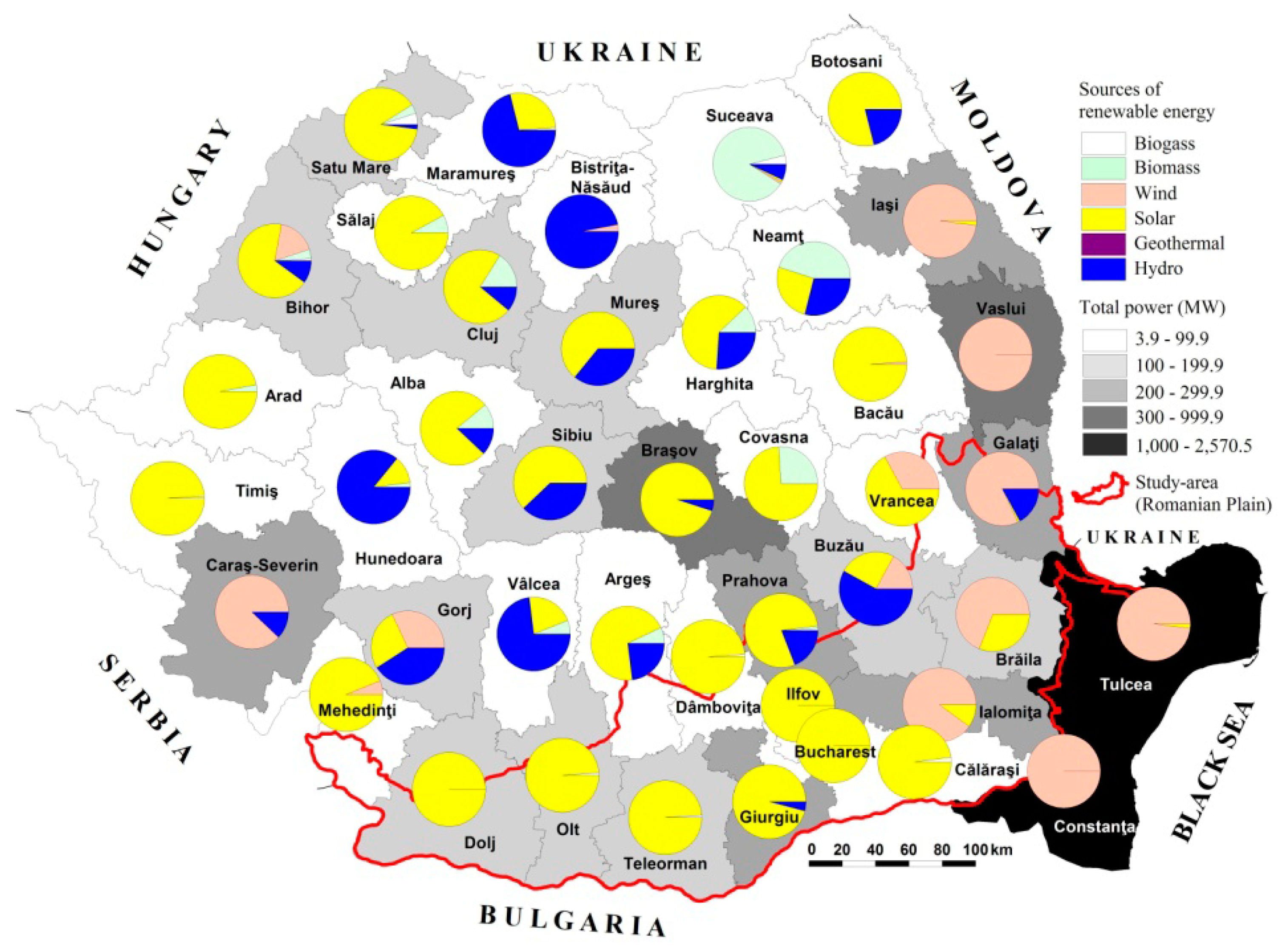
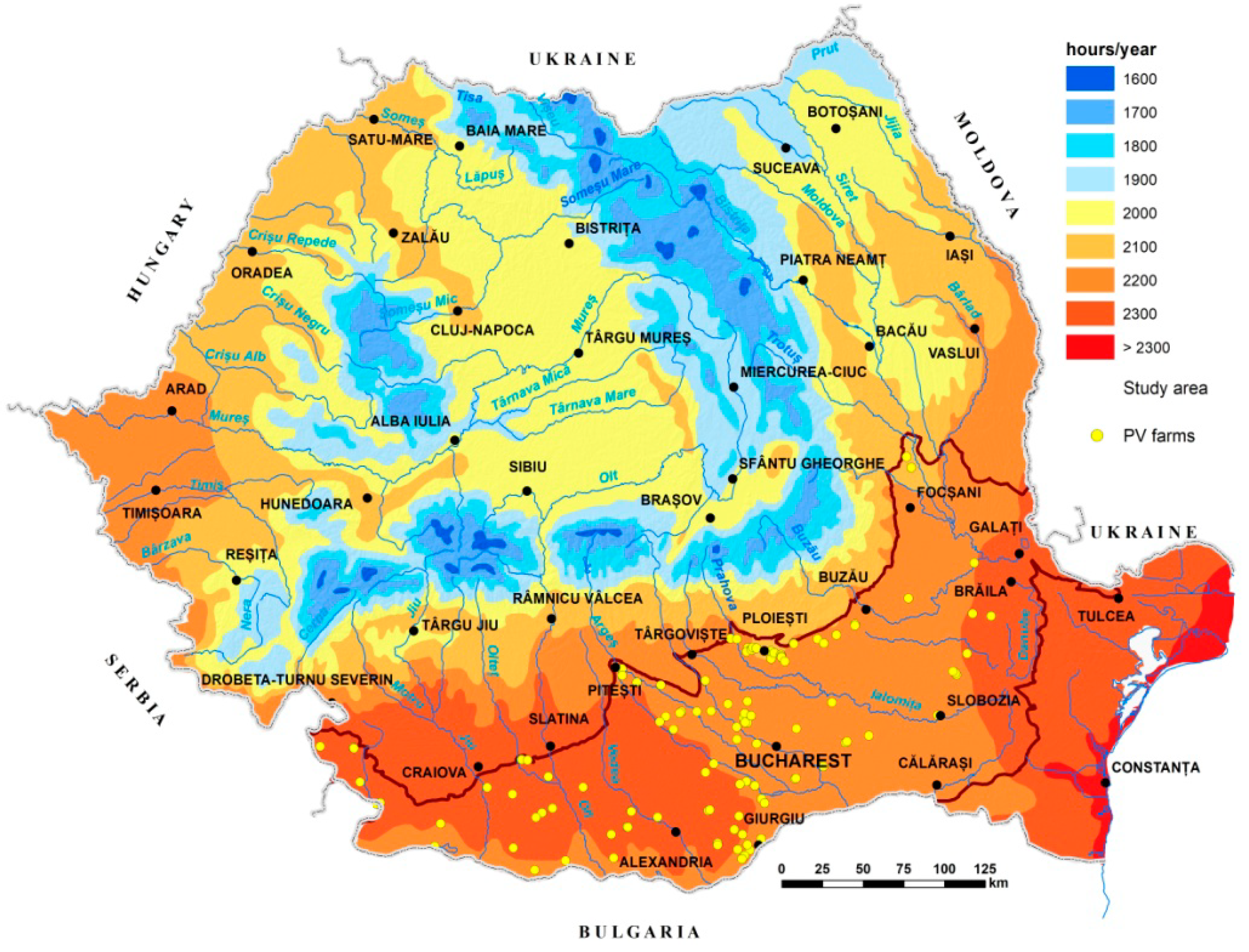
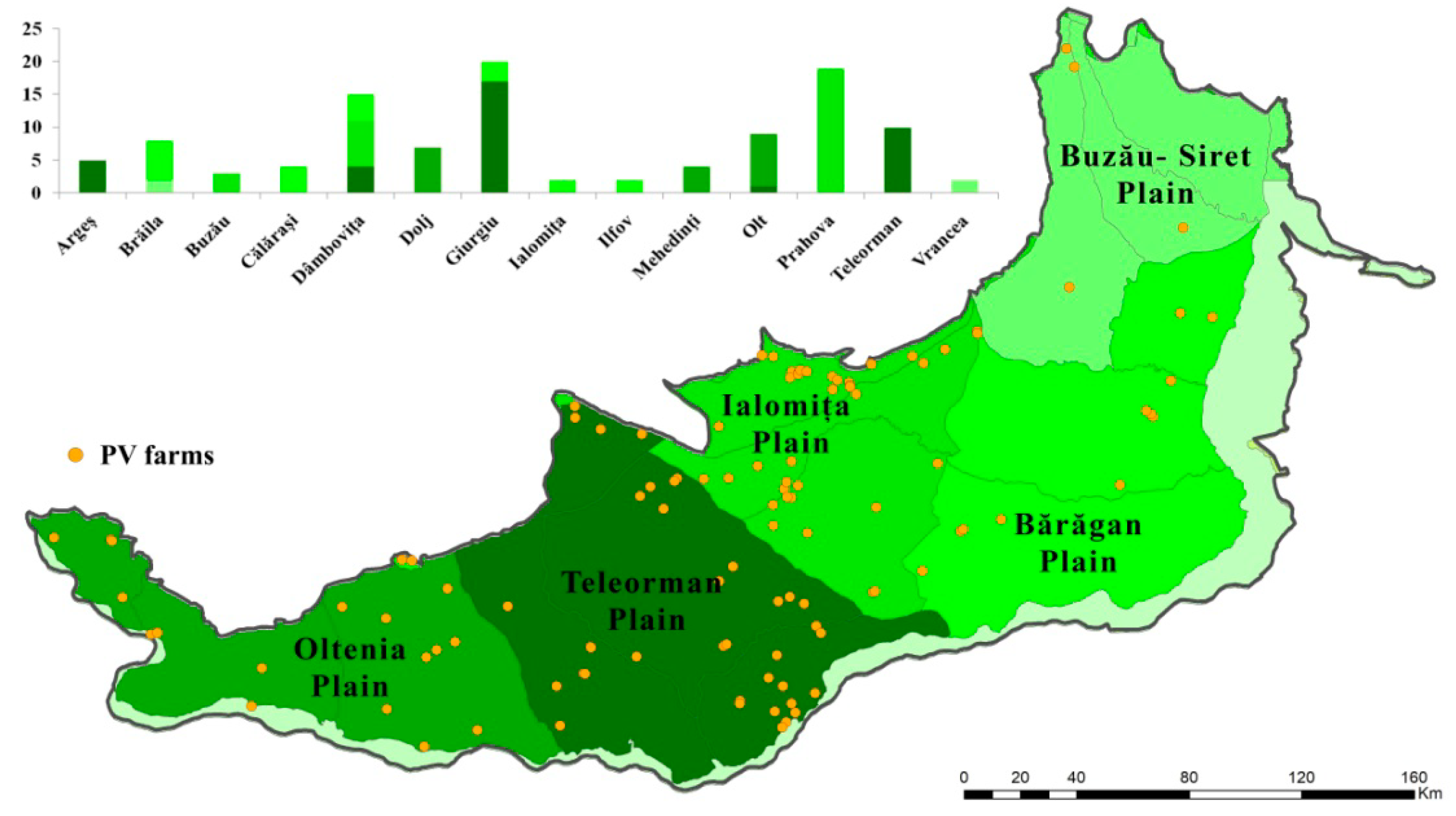
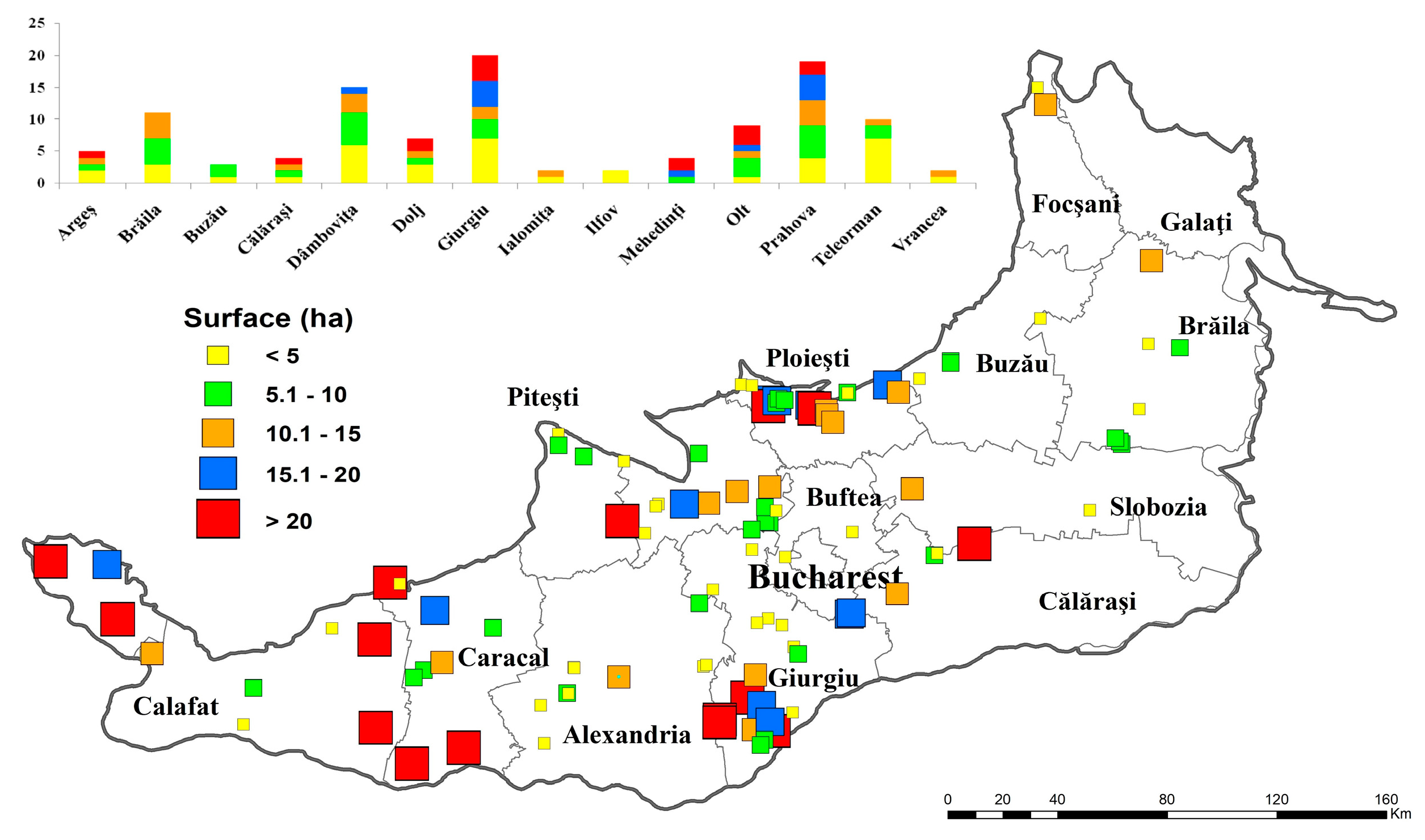
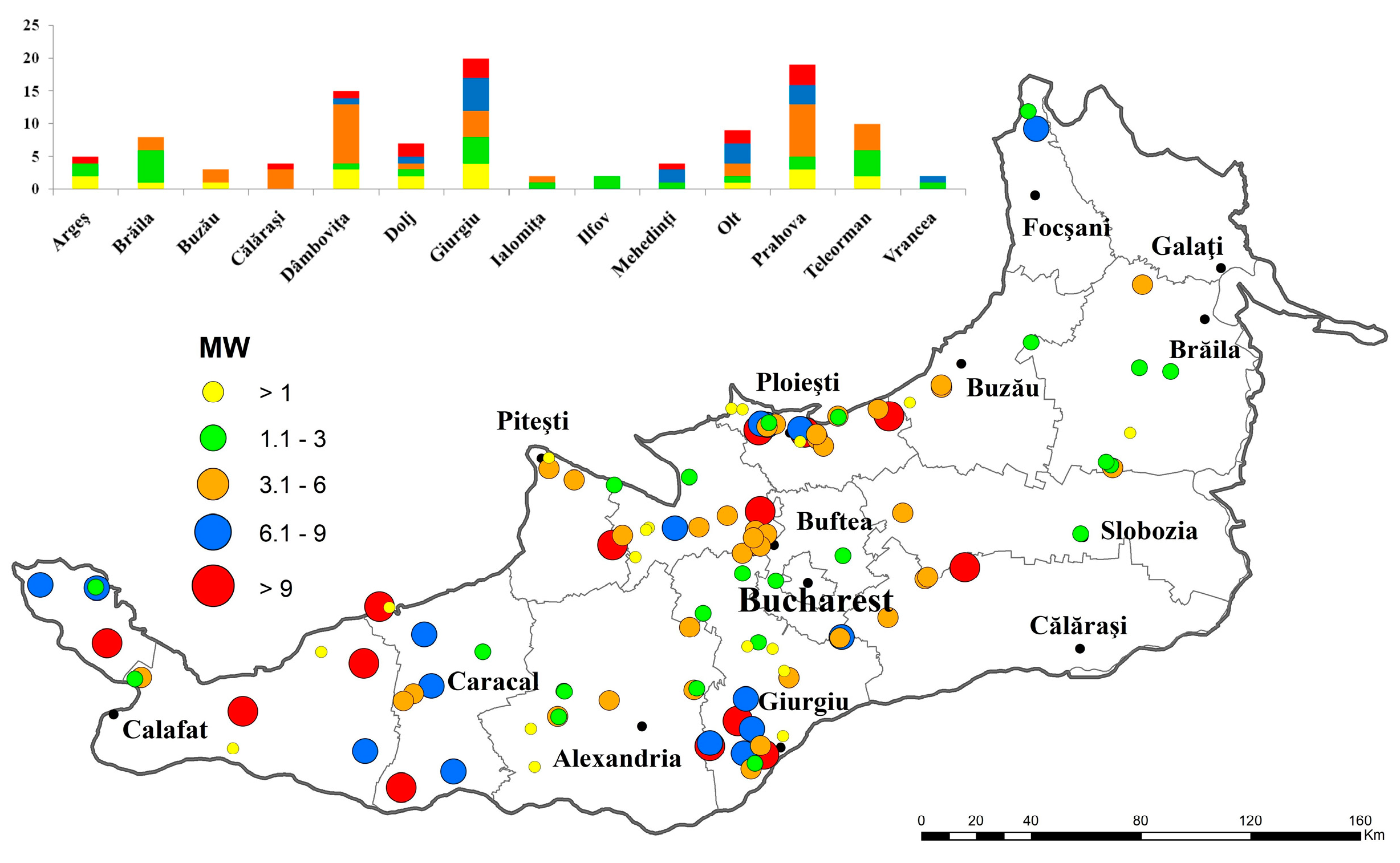
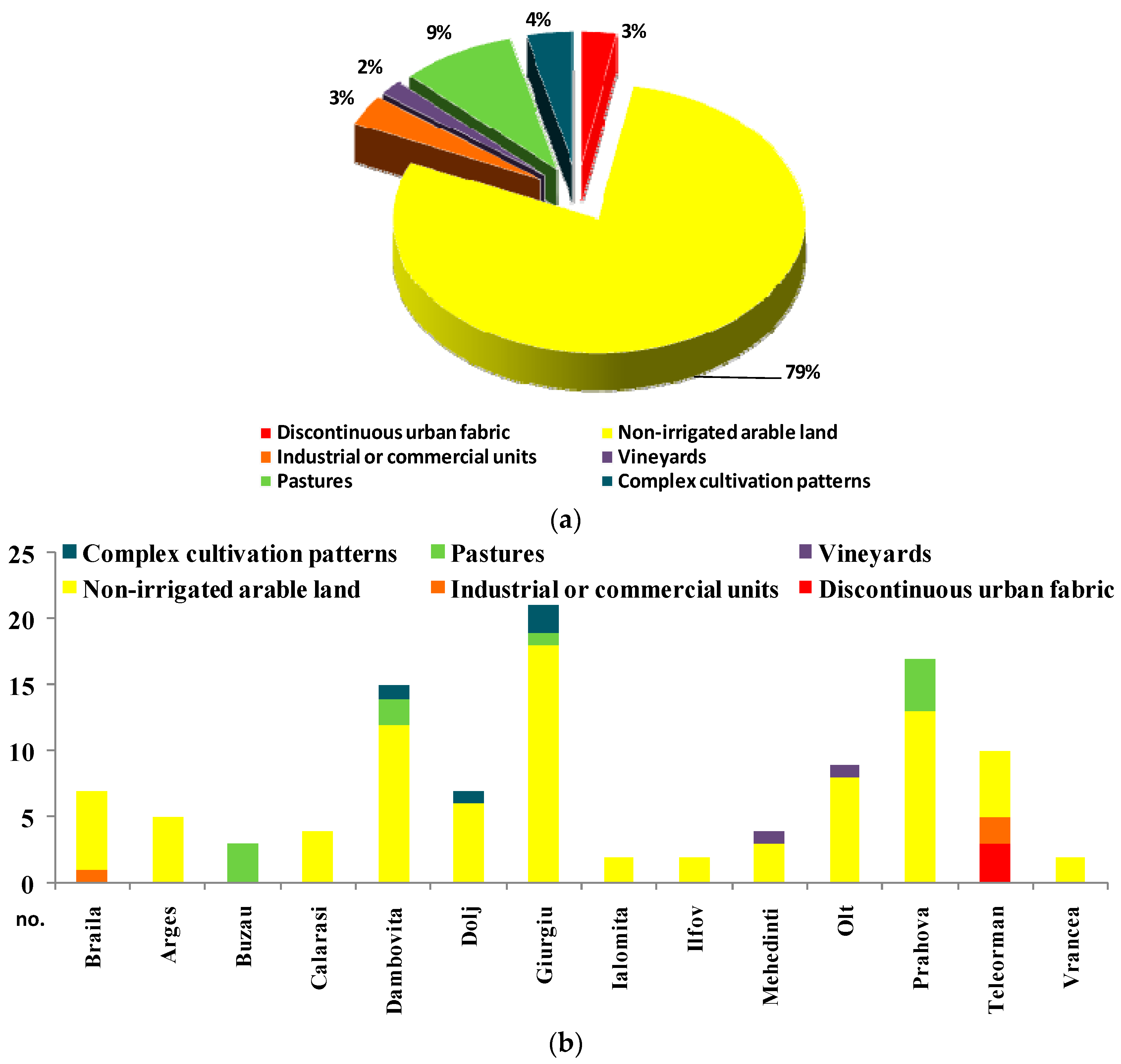
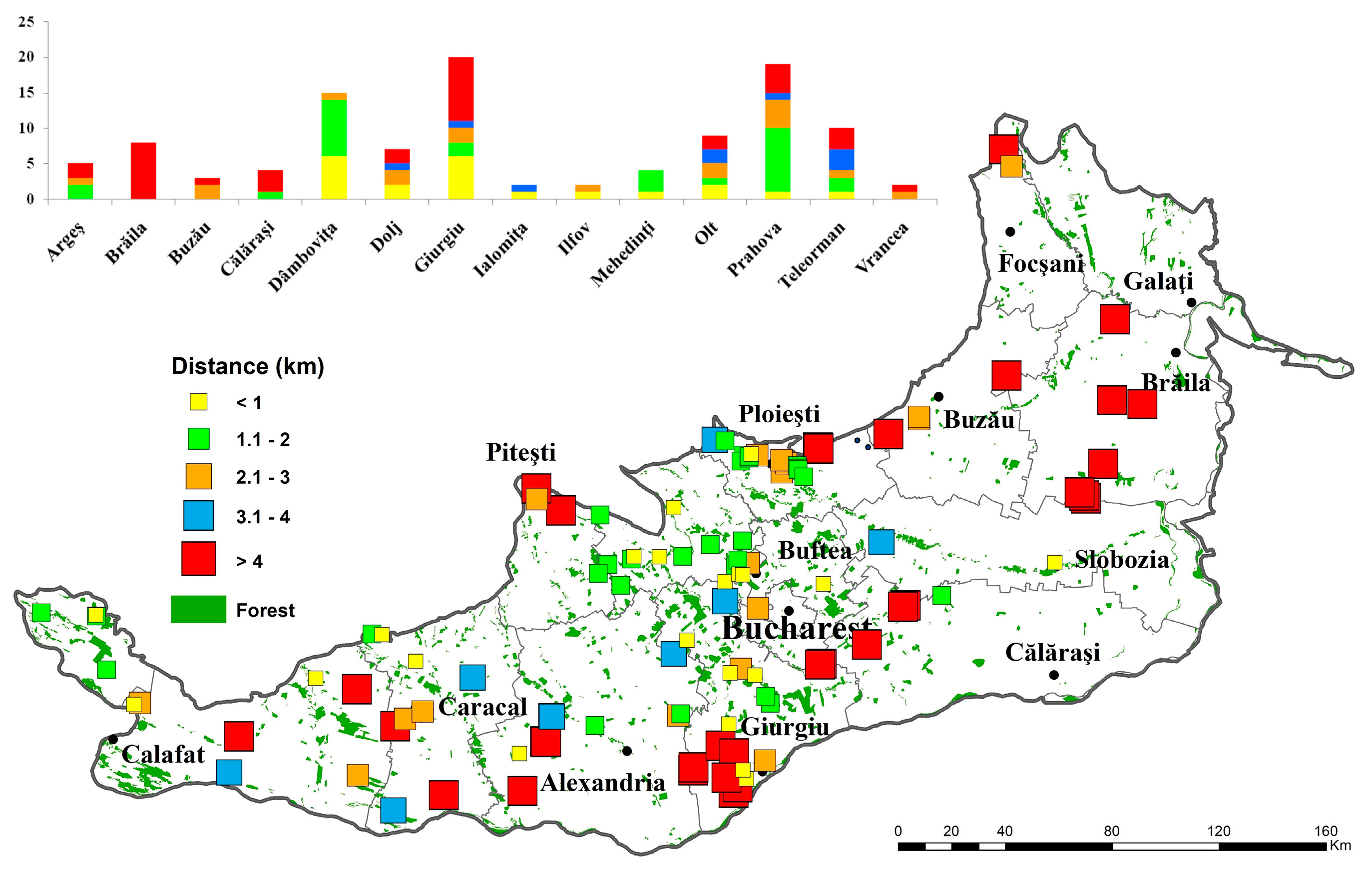
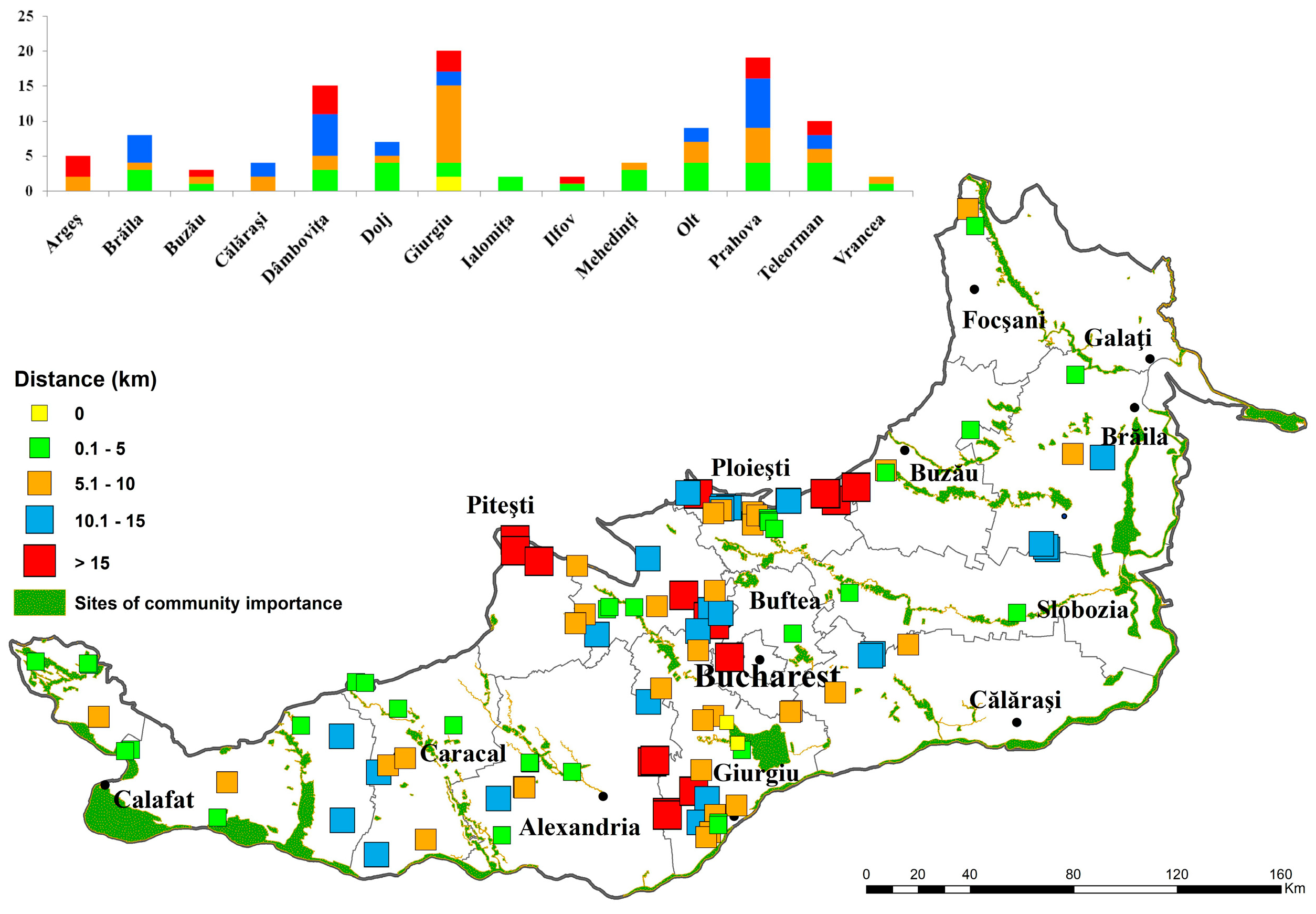
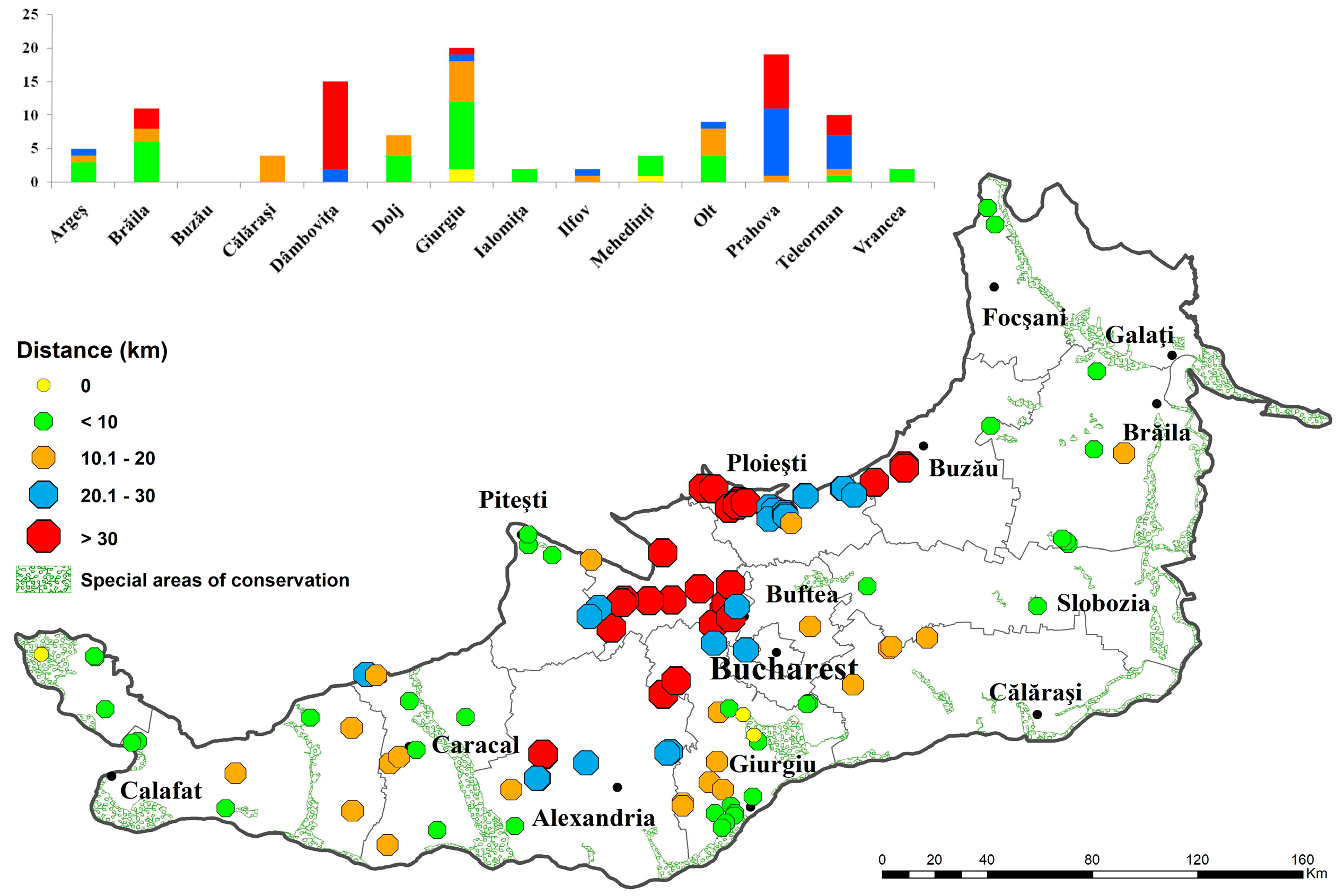

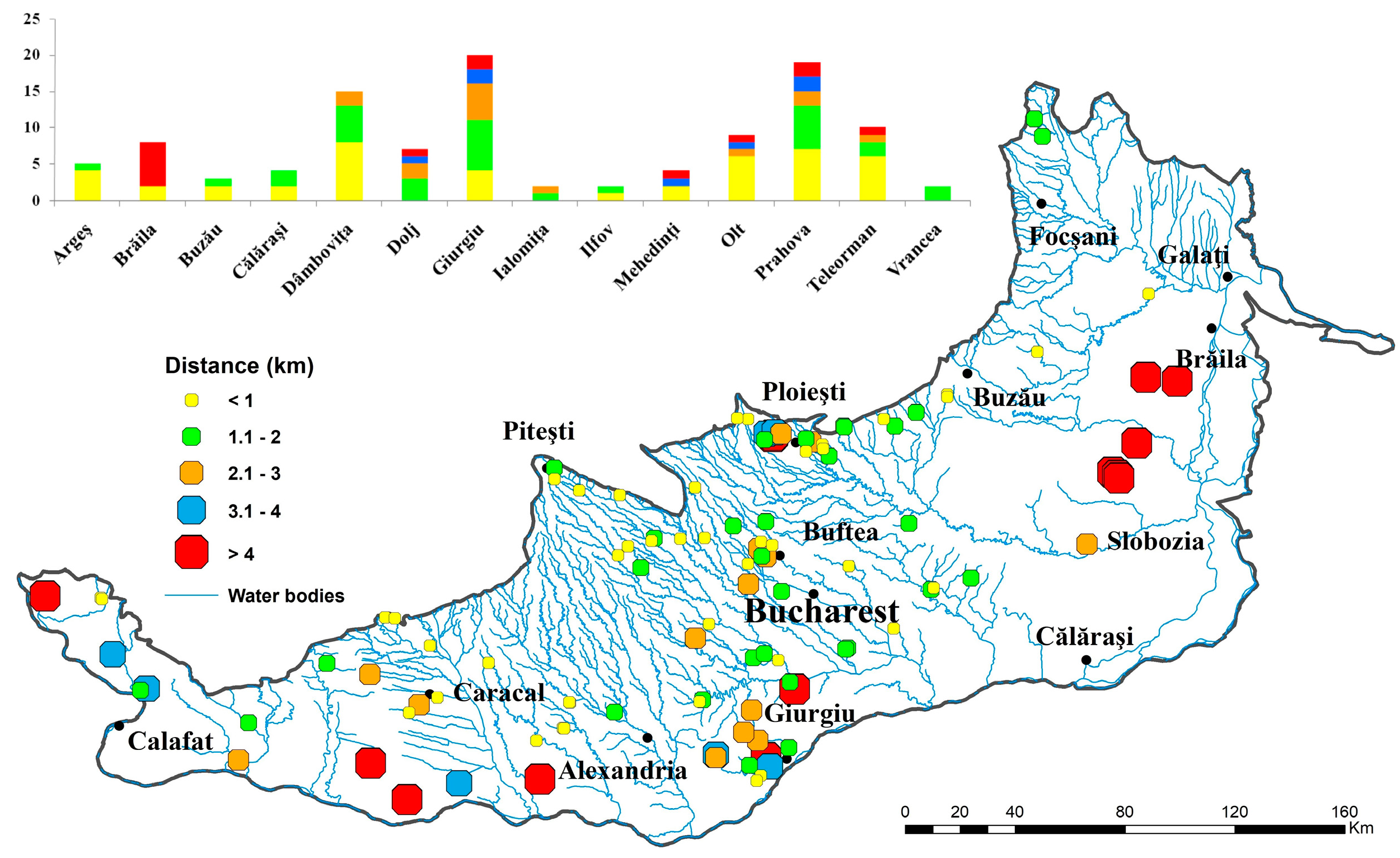
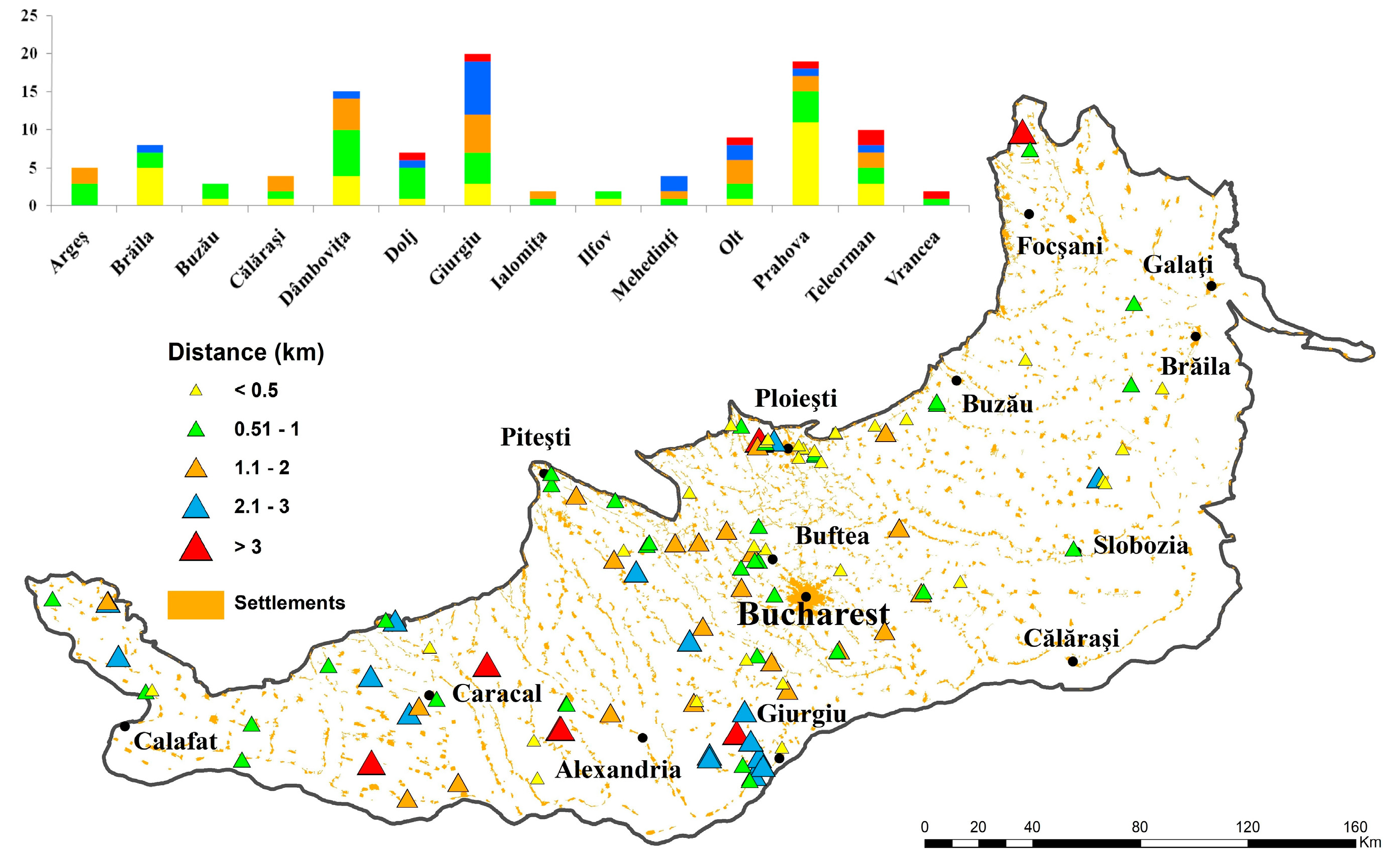
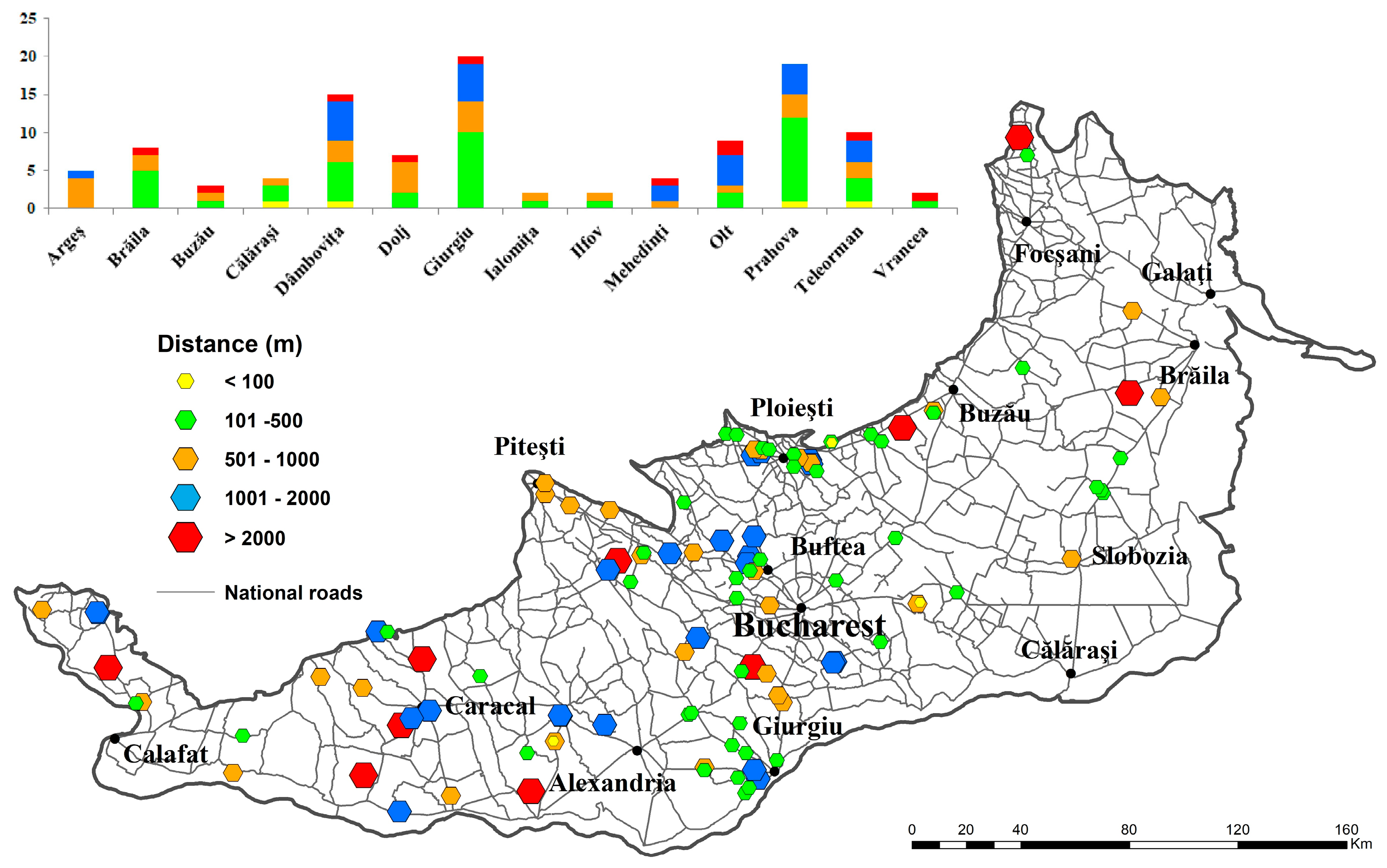
| Categories of Impacts | Positive | Negative |
|---|---|---|
| Land Use and Landscape |
|
|
| Ecosystems | N/A |
|
| Environmental Quality |
|
|
| Climate Change |
|
|
| Human health and Safety | N/A |
|
| Supporting Infrastructure |
|
|
| Public Awareness |
| N/A |
© 2019 by the authors. Licensee MDPI, Basel, Switzerland. This article is an open access article distributed under the terms and conditions of the Creative Commons Attribution (CC BY) license (http://creativecommons.org/licenses/by/4.0/).
Share and Cite
Vrînceanu, A.; Grigorescu, I.; Dumitrașcu, M.; Mocanu, I.; Dumitrică, C.; Micu, D.; Kucsicsa, G.; Mitrică, B. Impacts of Photovoltaic Farms on the Environment in the Romanian Plain. Energies 2019, 12, 2533. https://doi.org/10.3390/en12132533
Vrînceanu A, Grigorescu I, Dumitrașcu M, Mocanu I, Dumitrică C, Micu D, Kucsicsa G, Mitrică B. Impacts of Photovoltaic Farms on the Environment in the Romanian Plain. Energies. 2019; 12(13):2533. https://doi.org/10.3390/en12132533
Chicago/Turabian StyleVrînceanu, Alexandra, Ines Grigorescu, Monica Dumitrașcu, Irena Mocanu, Cristina Dumitrică, Dana Micu, Gheorghe Kucsicsa, and Bianca Mitrică. 2019. "Impacts of Photovoltaic Farms on the Environment in the Romanian Plain" Energies 12, no. 13: 2533. https://doi.org/10.3390/en12132533
APA StyleVrînceanu, A., Grigorescu, I., Dumitrașcu, M., Mocanu, I., Dumitrică, C., Micu, D., Kucsicsa, G., & Mitrică, B. (2019). Impacts of Photovoltaic Farms on the Environment in the Romanian Plain. Energies, 12(13), 2533. https://doi.org/10.3390/en12132533







